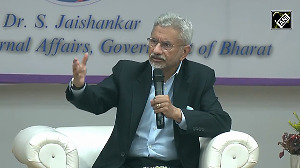Merely re-packaging models that have not worked well in the past will not do the trick.
A couple of weeks back, I had occasion to attend the annual conference of the Fixed Income, Money Market and Derivatives Association of India, in Agra. It was a well-attended conference, with more than 200 delegates participating.
However, less than 15 per cent of the participation came from the public sector banks in India, which, in terms of their deposits and lending portfolios, control 70 per cent plus of the banking system's aggregates.
While, in a way, this comparative lack of interest in the FIMMDA conference is understandable -- public sector banks as a group are not very active traders in the securities or derivatives markets -- it does not augur well for the development of the country's financial system.
(Incidentally, public sectors banks are also not active in areas like securitisation and structured finance, etc.)
One wonders whether, after having released a draft circular on credit derivatives almost four years ago, the RBI has developed cold feet as this could prove to be yet another area where the foreign and private sector banks will dominate and secure a competitive advantage over the PSBs.
While I will come back to the topic of credit derivatives later in the article, consider some specific proposals in the Budget relating to financial markets. The first one is the framing of regulations for the introduction of "exchangeable bonds" by corporate shareholders, or the government itself, against their holdings in listed companies.
In effect, such bonds would have an embedded option in favour of the holder to buy, from the issuer of the bond, his equity investments, at specified prices. The exercise price could well be at a premium to the current market price of the share, and there would obviously be a trade-off between it and the coupon on the bond.
The proposal to introduce reverse mortgages for senior citizens -- in effect, annuities payable through their lifetime against the value of a fully-paid-for house, or more or less so -- is welcome and would surely be found useful in the context of a gradual break-down of the joint Hindu family system, at least in urban India.
On the other hand, one is not quite clear about the floatation of mortgage guarantee companies. Who would promote them? With what kind of capitalisation? How would their long-term guarantees gain credibility? And, in as much as such guarantees would be similar to credit default swaps, which is the basic credit derivative, why not introduce credit derivatives on a more comprehensive basis?
One is also not convinced about the efficacy of the various proposals relating to regional rural banks. As it is, their total lending is less than 25 per cent of the commercial banks' portfolio of agricultural loans. While they do have a different, and lower, salary structure from the public sector banks, the business model remains that of branch banking.
Given the need for financial inclusion of the rural poor and small agriculturists, and the need to keep the intermediation cost low, is this business model appropriate? Surely, what we need is a different, technology-based model for delivery of services to such clients.
Banks like ICICI Bank, perhaps the most "commercial" bank of them all, have done a lot of work on the subject and I recall that management Guru CK Prahalad had also praised the model as innovative enough to reach those at the "bottom of the pyramid". Asia is generally well ahead of the West in the application of technology like mobile phones to payment and other financial services.
And, we have arguably the most competitive IT and sophisticated software development industry in Asia. Surely, we should be focusing on technology to extend the reach of financial services to the poor, rather than on strengthening the existing RRB branch banking model?
On the same point, some time back, there were reports of an RBI committee recommending the use of money lenders in the delivery of loans to the rural poor and agriculturists.
Nothing has been heard about it for quite some time; perhaps it has been buried as politically too incorrect.
Money lenders or technology, there is clearly a need for innovation in the delivery of services for extending financial inclusion to all.
Merely re-packaging models that have not worked well in the past will not do the trick. Incidentally, it is curious that RBBs are now being allowed to access non-resident deposits.
Is the MoF working at cross-purposes with the RBI, which recently dropped interest rates on non-resident funds to reduce the flow?
But to come back to the question of credit derivatives, as has been accepted by all the policymakers, we need a flourishing corporate bond market if the investment needs of the economy, particularly infrastructure finance, are to be met. The development of a corporate bond market would be helped immensely by the introduction of the credit
default swap, the most basic credit derivative: a CDS, in effect, would act as a bridge between corporate bonds and government bonds and would surely help in the development of a more active corporate bond market.
The Budget could also have been used to give one-time tax relief to bondholders for swapping existing G-secs to reduce the number of outstanding issues from over a hundred to perhaps 15 or 20, to improve secondary market liquidity.
There is another perspective to credit derivatives, in particular credit-linked notes. Recently, the RBI extended the scope of priority sector financing to foreign banks. In the era of "core competency" of different organisations, to my mind, it is less than logical to expect every bank to undertake every type of business, from micro finance and
agricultural funding to international banking.
Derivatives like credit-linked notes would allow some banks to specialise in priority sector lending, with the cost being borne by the entire system through sale by such banks of credit-linked notes to others who may not like to develop the organisational expertise for such business.
Priority sector quotas could be fulfilled by direct loans or holding CLNs. Credit derivatives would also give a focus to the broadly neglected issue of credit pricing in PSBs, given its relevance to Basel II.
Incidentally, using PAN as the sole identification for all investments was such an obvious and user-friendly procedure. That we needed a Budget speech for the purpose is a sad commentary on the investor-friendly procedures of those involved.







 © 2025
© 2025